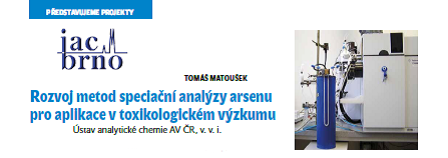Research
SPECIATION ANALYSIS
Contact persons: Tomáš Matoušek, Stanislav Musil
A modern trend in trace element analysis is to determine not only total element concentration, but also provide information on speciation – distribution of elements among various chemical forms in which they are present. Speciation is of paramount importance to understand toxicity and metabolism, or transport processes in the environment. The speciation analysis nowadays relies, by a great portion, on approach based on a liquid phase separation step followed by a sensitive element specific detection. The high performance liquid chromatography (HPLC), typically ion- exchange and ion-pairing, is by far, the most frequent separation techniques for speciation analysis. A very sensitive element specific detector such as inductively coupled plasma mass spectrometry (ICP-MS) must be used.
Unfortunately, this HPLC-ICP-MS approach is confined by principal limitations and practical problems. Complex samples require extraction of species with all associated risks, especially an incomplete yield and species transformation. In the separation step, species can be lost or transformed on a column. Its sensitivity is principally limited: sample volume is confined by a separation method, typically to 100 μL or less, and sample zone is broadened during separation. The main loss of analyte is experienced at the interface of LC to the plasma, i.e., in the nebulizer, since typical nebulization efficiency is only few percent.
An alternative and complementary approach to As speciation analysis is based on generation of volatile As species- (methylsubstituted) arsanes. Here, arsanes are preconcentrated and separated in a cryotrap filled by chromatographic packing (CT). The main limitations of the HPLC-ICP-MS are avoided: very little sample pretreatment is necessary and analyte from a relatively large volume of a sample is focused into a few second wide peak shaped signals, resulting in excellent limits of detection. The main drawback of the HG based approach is limited selectivity, as the CT step can distinguish only 4 volatile arsane species- arsine and mono-, di- and trimethylarsane. Therefore, the selectivity of the analysis is aided by the HG step, on the basis of the fact that some arsenic species do not form hydrides at certain conditions.
VARIOUS WAYS OF HYDRIDE GENERATION (HG) CAN BE EXPLORED FOR ALTERNATIVE AND COMPLEMENTARY APPROACHES TO SPECIATION ANALYSIS, OFFERING NEW POSSIBILITIES.
A step of HG included downstream from a HPLC column (postcolumn HG) can improve the efficiency of introduction of analyte into the detector, increasing the sensitivity. It also allows interfacing HPLC to the detectors, which require analyte introduction in the gaseous phase, such as AFS.
HG can produce different volatile products from analyte species containing various number of methyl or more commonly alkyl groups (methyl or alkyl substituted) hydrides. These can be preconcentrated and separated in a cryotrap filled by a chromatographic packing (CT). The main limitations of the HPLC-ICP-MS are avoided when very little sample pretreatment is necessary and analyte from a relatively large volume of a sample is focused into a few second wide peak shaped signals, resulting in excellent limits of detection. The main drawback of the HG based approach is limited selectivity, as the CT step can distinguish only volatile hydride species with different number of methyl or alkyl groups.
Depending on element chemical properties, HG activity of different analyte species at different conditions of HG can be very different. Some species do not form hydrides at certain conditions at all. This can be employed to selective determination of certain species without separation, or to aid the selectivity of HG-CT or postcolumn generation.
Our research activities in speciation analysis of: ARSENIC, GERMANIUM, MERCURY
Our popular articles on topic of arsenic and its speciation analysis (in Czech):




